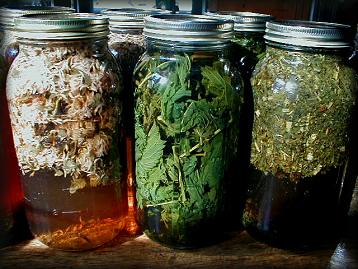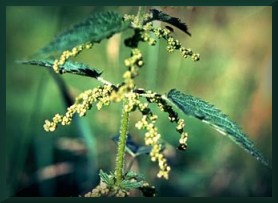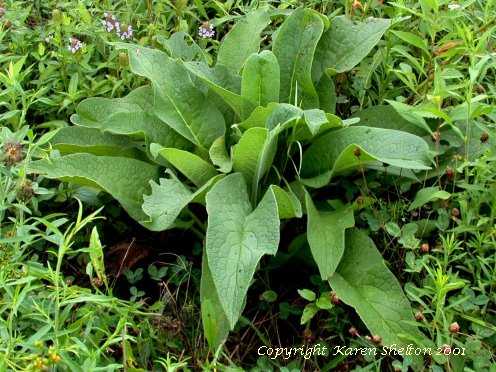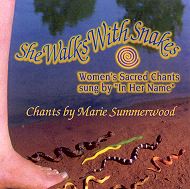On a road trip once I was captive in a car with someone who
took lots of supplements. He had a long litany about pills
and capsules. As he went on with it, I could notice inside
me just the beginnings of self-blame because I don't take
supplements generally. Fortunately I caught myself and when
he had finished I found myself saying, "I know what you
mean. I eat seaweed several times a week, I eat cooked dark
greens nearly everyday. I use herbal vinegars on salads, in
marinades and cooked beans. And I drink herbal infusions,
about a quart a day." I'd never said it all that clearly
before, and it made me realize just how rich my diet is in
plant-based mineral salts. This article is about herbal infusions.

It's easier to begin by talking about teas.
Infusions differ from teas in this way: a tea is made from
a small amount of herb (dry or fresh), boiling water, steeped
for a few minutes. You get tannins, essential oils, some alkaloids
like theine from black tea. Teas are often great tasting;
peppermint tea can settle your stomach, lemon balm tea (fresh
leaves best) helps with depression, the astringency of the
tannins is pleasant and often helps settle the stomach, ginger
tea helps with nausea. Teas are great, but they are not infusions.
An infusion is made from a lot of herb (always
dry), boiling water and is steeped several hours. You get
all of the abovementioned plus mineral salts. These mineral
salts are bio-available in wonderful profusion and good balance.
Dry herbs are used because drying the plant breaks the cell
wall. When the boiling water is poured over them the weakened
cell walls open and the mineral salts inside the cells come
into the infusion. I always use organic plants, as many medicinal
herbs are grown in Eastern Europe where the soil is highly
chemicalized.
On a practical note, get a system going for
the actual production; if it's not easy, it's more difficult
to keep up. I make my infusions in a Corningware coffee pot
without the usual basket innards. Use approximately 1 cup
of dried plant per quart of boiling water. Cover and let sit
at least 4 hours, or overnight. Make it a nightly ritual while
getting ready for bed. In the morning strain it into quart
jars and compost the spent plant material. No compost pile?
Scatter it in the garden or on the lawn to dry up and turn
to brown dust, adding to the local soil recipe.

 Nettles
(Urtica dioica) is my favorite. The taste is deep green, same
as the color. Richest in calcium, magnesium, manganese, chromium
and zinc, it also contains a pretty full panoply of other
minerals. Nettles is particularly restorative to the kidneys
and adrenals, and the tissues of the blood vessels. It strengthens
the liver and is considered an adaptogen for the immune system.
This means it supports the immune system toward flexibility;
many people with allergies find drinking nettle leaf infusion
to be very helpful. In the summer, ice cold infusion is deeply
satisfying to the thirst. My mother drinks it hot with milk
and sugar, but she's of English descent, that's what she's
used to. Some people like to add dried peppermint to nettle
leaf infusion, perhaps a tablespoon per quart. One caveat
on nettles; some people experience an increase in urine production,
so don't drink too much at night at first.
Nettles
(Urtica dioica) is my favorite. The taste is deep green, same
as the color. Richest in calcium, magnesium, manganese, chromium
and zinc, it also contains a pretty full panoply of other
minerals. Nettles is particularly restorative to the kidneys
and adrenals, and the tissues of the blood vessels. It strengthens
the liver and is considered an adaptogen for the immune system.
This means it supports the immune system toward flexibility;
many people with allergies find drinking nettle leaf infusion
to be very helpful. In the summer, ice cold infusion is deeply
satisfying to the thirst. My mother drinks it hot with milk
and sugar, but she's of English descent, that's what she's
used to. Some people like to add dried peppermint to nettle
leaf infusion, perhaps a tablespoon per quart. One caveat
on nettles; some people experience an increase in urine production,
so don't drink too much at night at first.
 Oatstraw
(Avena sativa) is often quite deep gold in color, and tastes
slightly sweet. The taste reminds people of straw, because
that is what it is; one person I knew hated it because it
reminded her of all the mornings she had to get up early to
milk the cows. But mostly people like oatstraw right away.
It is made from the dried stem, leaf and seeds, harvested
and dried when the seeds are still soft, called "in milk".
If you crush such a seed between your fingers, you get a milky
residue. It's this milk that gives oatstraw its sweetness,
so if the oatstraw you buy has absolutely no seeds, it will
be less sweet. Oatstraw is richest in chromium, magnesium,
silicon and calcium. It is considered widely to be very restorative
to the nervous system in many general and specific ways. Its
benefits are cumulative; with all herbal infusions we reap
profound results over time.
Oatstraw
(Avena sativa) is often quite deep gold in color, and tastes
slightly sweet. The taste reminds people of straw, because
that is what it is; one person I knew hated it because it
reminded her of all the mornings she had to get up early to
milk the cows. But mostly people like oatstraw right away.
It is made from the dried stem, leaf and seeds, harvested
and dried when the seeds are still soft, called "in milk".
If you crush such a seed between your fingers, you get a milky
residue. It's this milk that gives oatstraw its sweetness,
so if the oatstraw you buy has absolutely no seeds, it will
be less sweet. Oatstraw is richest in chromium, magnesium,
silicon and calcium. It is considered widely to be very restorative
to the nervous system in many general and specific ways. Its
benefits are cumulative; with all herbal infusions we reap
profound results over time.
 Red
Clover (trifolium praetense) grows in your back yard,
or down the street. The flowers are actually purple in color.
Harvest flowers for infusion, along with the set of leaves
that closely collars the flower. Dry them out flat, not touching.
This infusion tastes the most like black tea, largely because
of its tannins. But red clover is rich in chromium, tin, calcium,
magnesium, phosphorous, potassium and thiamine. It is often
used to promote fertility, used daily for 3 months. It has
good amounts of phytoestrogens that the body can use to make
estrogens, so it can help soften symptoms of menoopause. It
is also widely used as an anti-cancer herb.
Red
Clover (trifolium praetense) grows in your back yard,
or down the street. The flowers are actually purple in color.
Harvest flowers for infusion, along with the set of leaves
that closely collars the flower. Dry them out flat, not touching.
This infusion tastes the most like black tea, largely because
of its tannins. But red clover is rich in chromium, tin, calcium,
magnesium, phosphorous, potassium and thiamine. It is often
used to promote fertility, used daily for 3 months. It has
good amounts of phytoestrogens that the body can use to make
estrogens, so it can help soften symptoms of menoopause. It
is also widely used as an anti-cancer herb.
 Comfrey
(Symphytum Uplandica) has the folk name of Knitbone and it
does that so well! The high allantoin content of the leaf
infusion supports cell proliferation in the healing process
of bones. During WWI medics used allantoin for healing war
injuries. The infusion can have a slippery feel to it, that's
the allantoin. Some people like to add a little dried peppermint.
Comfrey leaf infusion also helps heal lung tissues; many a
longterm case of bronchitis has responded to consistent use.
Comfrey
(Symphytum Uplandica) has the folk name of Knitbone and it
does that so well! The high allantoin content of the leaf
infusion supports cell proliferation in the healing process
of bones. During WWI medics used allantoin for healing war
injuries. The infusion can have a slippery feel to it, that's
the allantoin. Some people like to add a little dried peppermint.
Comfrey leaf infusion also helps heal lung tissues; many a
longterm case of bronchitis has responded to consistent use.

One last infusion I really like is:
 Mullein
leaf (Verbascum thapsus). Mullein plants are the
4-6 foot tall spikes with yellow flower tops you see along
the highway in the summer. The infusion has a dark brown color
and taste that makes me feel like I am drinking the earth.
Richest in iron, aluminum,calcium, chromium, cobalt, magnesium,
manganese, niacin, phosphorous and silicon, this infusion's
other major benefit is to the lungs. Used to treat coughs,
colds, croup, bronchitis and asthma, it is often traditionally
drunk with milk and honey. (My mother would be pleased). It's
also delicious unadorned.
Mullein
leaf (Verbascum thapsus). Mullein plants are the
4-6 foot tall spikes with yellow flower tops you see along
the highway in the summer. The infusion has a dark brown color
and taste that makes me feel like I am drinking the earth.
Richest in iron, aluminum,calcium, chromium, cobalt, magnesium,
manganese, niacin, phosphorous and silicon, this infusion's
other major benefit is to the lungs. Used to treat coughs,
colds, croup, bronchitis and asthma, it is often traditionally
drunk with milk and honey. (My mother would be pleased). It's
also delicious unadorned.
Herbal infusions are easy and delicious ways
to enhance your mineral intake. Your local coop may well carry
all that are mentioned here. You can buy a cup of one and
try a quart of infusion. Drink it hot or cold, plain, sweetened
or with a splash of tamari. When you discover the ones you
love, you can harvest them yourself (that's another article)
or buy them by the pound. You'll want that much around. Profound
Results Over Time is the byline for nourishing herbal infusions
. You can believe it!
by Marie
Summerwood
Bibliography:
Nutritional Herbology, Mark Pederson,Wendall W. Whitman
Company, 1998
Wildflowers-Northeastern/North-central North America,
Peterson Field Guide, Houghton Mifflin, 1996 (excellent
for identifying wild plants)

 Click
here to learn more about her fabulous CD
Click
here to learn more about her fabulous CD
She Walks With Snakes
Women's Sacred Chants.





 Click
here to learn more about her fabulous CD
Click
here to learn more about her fabulous CD